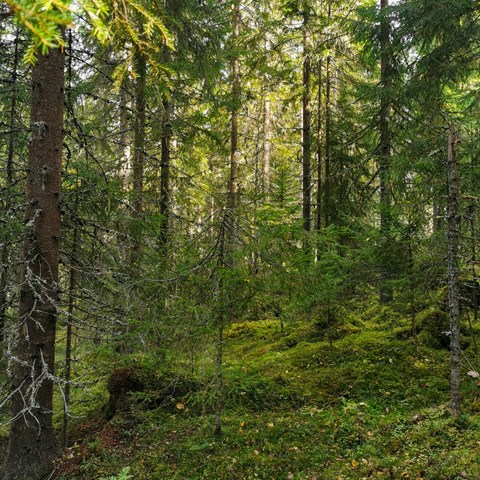The main silviculture system in Sweden is the rotation forestry system. This system follows a rotation where a forest is regenerated by planting or seed trees, and then subsequently thinned until the stand is later clear cut at an age of 60 to 120 years.
Clearcutting is to the disadvantage of several forest-dwelling species, which is why it is important to find out how other types of silviculture, such as continuous cover forestry affect both biodiversity and forest growth, says Jörgen Sjögren, researcher at SLU and one of the authors of the article.
In this new literature review, the researchers compare the rotation forestry system to the selection system, which is a type of continuous cover forestry. This system is practiced in spruce forests with a high variation in tree size – where both small and large trees are present in all parts of the stand, but with significantly more small than large trees; a so-called full-storied forest. In this type of forestry, the largest trees are harvested with single-tree selection at intervals of about every five to thirty years.
Many species remain during the first years after single-tree selection felling
After reviewing over 1,200 scientific publications, the researchers identified 17 studies comparing long-term yield and 21 comparing biodiversity between the selection system and the rotation forestry system. They found that many species survive the first years after single-tree selection and that the species assemblage differed substantially from a clearcut. For beetles, studies indicate that mid-age forests managed with the rotation forestry system has a similar assemblage as forest managed with the selection system. However, it is not known if this applies to other species groups. The researchers also found that there are few studies comparing forests managed with the selection system to older forests managed with rotation forestry. This makes is more difficult to evaluate how biodiversity differs between management systems.
"On a short-term basis, single-tree selection seems to preserve many forest-dwelling species, but we do not yet know the long-term effects. In addition, we found few studies on threatened or red-listed species, so we could not draw any conclusions about how these species are affected by the selection system," says Jörgen Sjögren, a researcher at SLU.
Selection felling and forest growth
Few studies have compared the long-term yields between the selection system and the rotation forestry system. Among these studies, very few represent long-term experiments and many of these had major problems in their experimental design. Instead, most comparisons are based on mathematical models where growth has been simulated over a long period. Some, but not all of these studies showed higher growth for the rotation forestry system. Therefore, foresters should keep in mind that the selection system may or may not result in lower growth than the rotation forestry system.
"Today, there are few multi-storied forests in Sweden. If these are harvested with clearcutting, it will be difficult to apply the selection system, as it takes time to create new multi-storied forests, and it would likely result in low growth in these forests during the transformation phase. If the choice is between managing the remaining full-storied forests with clearcutting or the selection system, it may be appropriate to use the selection system while waiting for more knowledge on how both long-term yield and biodiversity are affected by the different silviculture systems," says Adam Ekholm, former postdoctoral scientist at SLU.
This massive literature review reveals an important gap in knowledge, and the researchers are calling for more studies on the long-term effects on biological diversity, especially on threatened species. There is also a need to establish a long-term research infrastructure focused on alternatives to the rotation forestry system.

